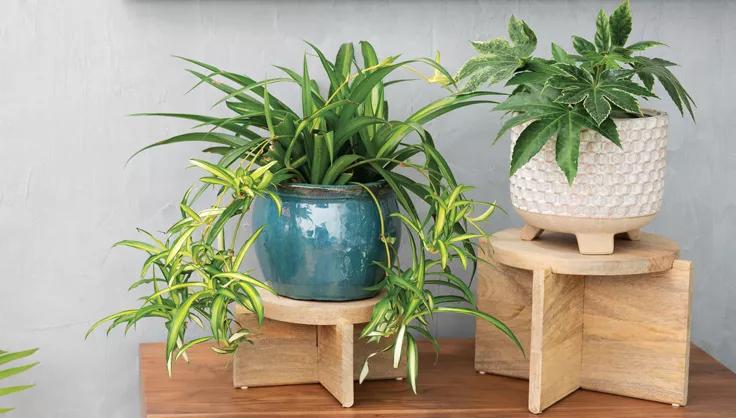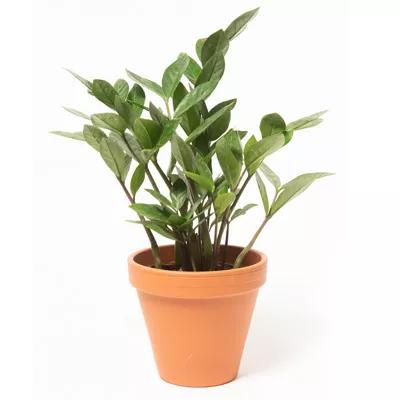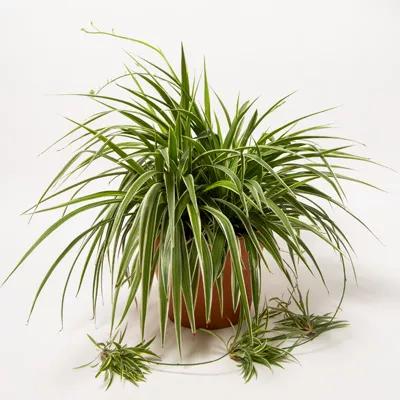5 Easy Houseplants For Any Home
Hard-to-kill houseplants for any gardener of any ability

You don’t need to be a master gardener to have a lush collection of houseplants. There are tons of beautiful houseplants that don't need to be coddled and won't dry up the first time you forget to water them. (And some of them actually prefer to be slightly forgotten!).
Here are some of our favorite houseplants that require minimal maintenance:
Snake Plant
Dracaena trifasciata

When it needs water: Water snake plants every 3-4 weeks, or when the soil is completely dry. Overwatering is the biggest threat to snake plants. Choose a heavy pot or planter for the taller varieties because the weight of their sword-like leaves can topple the plant, especially when the soil is dry.
How much light: Snake plants can handle very low light easily, although their growth may slow considerably; they thrive best in medium, indirect light.
Why it’s great: Their drought-tolerance, combined with their ability to thrive in semi- dark corners, means that snake plants may win the award for “easiest houseplant”.
ZZ Plant
Zamioculus zamiifolia

When it needs water: Like the snake plant, the ZZ plant is drought-hardy, and only needs to be watered every 3 weeks or so. ZZ plants have thick roots, called rhizomes, that help it store water for dry periods.
How much light: ZZ plants can tolerate medium to low amounts of light. Wild ZZ plants originate from the shady forests of southeastern Africa — these places tend to be dry but not very sunny.
Why it’s great: The shiny, almost plastic-looking leaves of the ZZ plant are visually attractive, but also serve an important function — the waxy coating on the leaves is an adaptation to help it avoid water loss.
Want more tips for terrific snake and ZZ plants? Watch below:
Spider Plant
Chlorophytum comosum

When it needs water: Spider plants like lightly moist but not soggy soil — water once a week or so. Dry crispy tips often point to underwatering while dark brown tips indicate overwatering.
How much light: Spider plants grow best in a bright room, although they will tolerate medium levels of light. Variegated varieties will develop bolder stripes under brighter conditions.
Why it’s great: It's clump-forming shape and graceful arching leaves means allow the spider plant to be displayed in a variety of ways, from windowsill to hanging planter.
Aloe Vera
Aloe vera

When it needs water: As a desert native, aloe prefers a deep drink of water at infrequent intervals — aim for a thorough watering every 3 weeks or so. To ensure your plant isn't sitting soggy, plant your aloe in gravelly, porous soil and make sure your container has adequate drainage holes.
How much light: Like most succulents, aloe plants appreciate plenty of bright light. No sunny windows? Get your aloe under a full-spectrum grow light instead.
Why it’s great: Aloe vera is known for its soothing, medicinal gel, which can be squeezed out of plant leaves onto minor scrapes and sunburns. Pet owners take note: despite its skincare benefits, aloe is poisonous to pets.
Pothos
Epipremnum aureum

When it needs water: Like many houseplants, pothos plants like to be deeply watered and then allowed to dry out beween waterings. Water once a week or so
How much light: Pothos plants are extremely tolerant of all light levels. These vigorous trailing plants grow happily in low light conditions, however variegated varieties may revert to all-green foliage.
Why it’s great: Pothos are extremely easy to propagate from cuttings. Simply snip a healthy stem below a leaf node and set in a glass of fresh water until roots appear. Then pot up your new pothos!
Print this Article:
Get the Dirt
Stay up to date on new articles and advice. Please fill out the information below.


